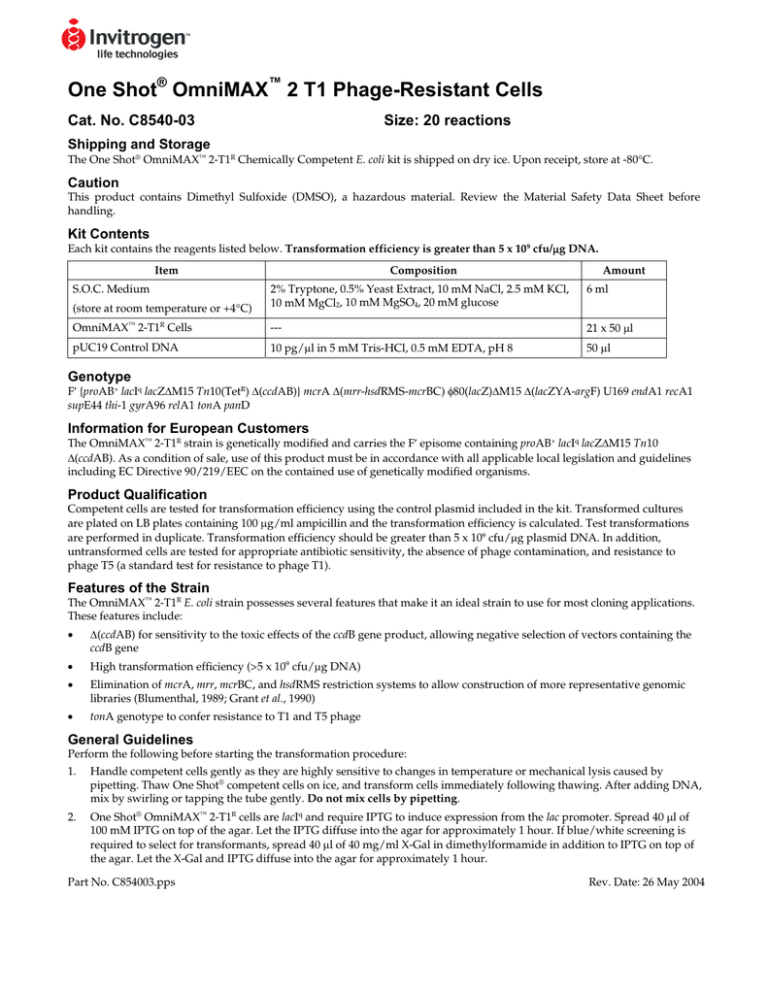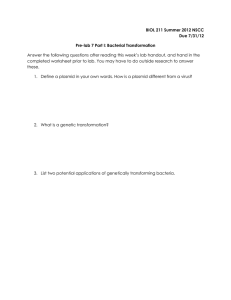One Shot® OmniMAX™ 2 T1 Phage-Resistant Cells
advertisement

One Shot® OmniMAX™ 2 T1 Phage-Resistant Cells
Cat. No. C8540-03
Size: 20 reactions
Shipping and Storage
The One Shot® OmniMAX™ 2-T1R Chemically Competent E. coli kit is shipped on dry ice. Upon receipt, store at -80°C.
Caution
This product contains Dimethyl Sulfoxide (DMSO), a hazardous material. Review the Material Safety Data Sheet before
handling.
Kit Contents
Each kit contains the reagents listed below. Transformation efficiency is greater than 5 x 109 cfu/µg DNA.
Item
Composition
Amount
2% Tryptone, 0.5% Yeast Extract, 10 mM NaCl, 2.5 mM KCl,
10 mM MgCl2, 10 mM MgSO4, 20 mM glucose
6 ml
OmniMAX™ 2-T1R Cells
---
21 x 50 µl
pUC19 Control DNA
10 pg/µl in 5 mM Tris-HCl, 0.5 mM EDTA, pH 8
50 µl
S.O.C. Medium
(store at room temperature or +4°C)
Genotype
F′ {proAB+ lacIq lacZ∆M15 Tn10(TetR) ∆(ccdAB)} mcrA ∆(mrr-hsdRMS-mcrBC) φ80(lacZ)∆M15 ∆(lacZYA-argF) U169 endA1 recA1
supE44 thi-1 gyrA96 relA1 tonA panD
Information for European Customers
The OmniMAX™ 2-T1R strain is genetically modified and carries the F′ episome containing proAB+ lacIq lacZ∆M15 Tn10
∆(ccdAB). As a condition of sale, use of this product must be in accordance with all applicable local legislation and guidelines
including EC Directive 90/219/EEC on the contained use of genetically modified organisms.
Product Qualification
Competent cells are tested for transformation efficiency using the control plasmid included in the kit. Transformed cultures
are plated on LB plates containing 100 µg/ml ampicillin and the transformation efficiency is calculated. Test transformations
are performed in duplicate. Transformation efficiency should be greater than 5 x 109 cfu/µg plasmid DNA. In addition,
untransformed cells are tested for appropriate antibiotic sensitivity, the absence of phage contamination, and resistance to
phage T5 (a standard test for resistance to phage T1).
Features of the Strain
The OmniMAX™ 2-T1R E. coli strain possesses several features that make it an ideal strain to use for most cloning applications.
These features include:
•
∆(ccdAB) for sensitivity to the toxic effects of the ccdB gene product, allowing negative selection of vectors containing the
ccdB gene
•
High transformation efficiency (>5 x 109 cfu/µg DNA)
•
Elimination of mcrA, mrr, mcrBC, and hsdRMS restriction systems to allow construction of more representative genomic
libraries (Blumenthal, 1989; Grant et al., 1990)
•
tonA genotype to confer resistance to T1 and T5 phage
General Guidelines
Perform the following before starting the transformation procedure:
1.
Handle competent cells gently as they are highly sensitive to changes in temperature or mechanical lysis caused by
pipetting. Thaw One Shot® competent cells on ice, and transform cells immediately following thawing. After adding DNA,
mix by swirling or tapping the tube gently. Do not mix cells by pipetting.
2.
One Shot® OmniMAX™ 2-T1R cells are lacIq and require IPTG to induce expression from the lac promoter. Spread 40 µl of
100 mM IPTG on top of the agar. Let the IPTG diffuse into the agar for approximately 1 hour. If blue/white screening is
required to select for transformants, spread 40 µl of 40 mg/ml X-Gal in dimethylformamide in addition to IPTG on top of
the agar. Let the X-Gal and IPTG diffuse into the agar for approximately 1 hour.
Part No. C854003.pps
Rev. Date: 26 May 2004
Page 2
Transforming Competent Cells
Perform the following before starting the transformation procedure:
•
Equilibrate a water bath to 42°C.
•
Warm the vial of S.O.C. Medium (supplied with the kit) and LB Medium to room temperature.
•
Spread IPTG or IPTG and X-Gal onto LB agar plates containing antibiotic, if desired.
•
Warm the selective plates in a 37°C incubator for 30 minutes (use one plate for each transformation). If you are including
the pUC19 control, make sure that you have one LB agar plate containing 100 µg/ml ampicillin.
Transformation Procedure
Use the following procedure to transform One Shot® OmniMAX™ 2-T1R chemically competent E. coli. We recommend
including the pUC19 control plasmid DNA supplied with the kit in your transformation experiment to verify the efficiency of
the competent cells. Do not use these cells for electroporation.
1.
Thaw, on ice, one vial of One Shot® OmniMAX™ 2-T1R chemically competent cells for each transformation.
2.
Add 1 to 5 µl of the DNA (10 pg to 100 ng) into a vial of One Shot® cells and mix gently. Do not mix by pipetting up and
down. If you are transforming the pUC19 control, add 1 µl (10 pg) into a separate vial of One Shot® cells and mix gently.
3.
Incubate the vial(s) on ice for 30 minutes.
4.
Heat-shock the cells for 30 seconds at 42°C without shaking.
5.
Remove the vial(s) from the 42°C bath and place them on ice for 2 minutes.
6.
Add 250 µl of pre-warmed S.O.C. Medium to each vial.
7.
Cap the vial(s) tightly and shake horizontally at 37°C for 1 hour at 225 rpm in a shaking incubator.
8.
Before plating, dilute the transformation mix 1:50 into LB Medium (e.g. remove 10 µl of the transformation mix and add to
490 µl of LB Medium).
9.
Spread 25-100 µl of the diluted transformation mix on a pre-warmed selective plate. Store the remaining undiluted and
diluted transformation mix at +4°C. Additional cells may be plated out the next day, if desired.
10. Invert the plate(s) and incubate at 37°C overnight.
11. Select colonies and analyze by plasmid isolation, PCR, or sequencing.
Calculating Transformation Efficiency
Use the following formula to calculate the transformation efficiency as transformants (in cfu) per µg of plasmid DNA, where
DF is the dilution factor.
# of colonies
10 pg transformed DNA
x
106 pg
µg
x
300 µl total transformation volume
X µl plated
x
50 (DF)
=
# transformants
µg plasmid DNA
Limited Use Label License No. 91: F Prime Competent Cells
This product is the subject of U.S. Patent No. 6,274,369 owned by Invitrogen Corporation. The purchase of this product conveys to the buyer the non-transferable right to use the purchased
amount of the product and components of the product in research conducted by the buyer (whether the buyer is an academic or for-profit entity). The buyer cannot sell or otherwise transfer
(a) this product (b) its components or (c) materials made using this product or its components to a third party or otherwise use this product or its components or materials made using this
product or its components for Commercial Purposes. The buyer may transfer information or materials made through the use of this product to a scientific collaborator, provided that such
transfer is not for any Commercial Purpose, and that such collaborator agrees in writing (a) to not transfer such materials to any third party, and (b) to use such transferred materials and/or
information solely for research and not for Commercial Purposes. Commercial Purposes means any activity by a party for consideration and may include, but is not limited to: (1) use of the
product or its components in manufacturing; (2) use of the product or its components to provide a service, information, or data; (3) use of the product or its components for therapeutic,
diagnostic or prophylactic purposes; or (4) resale of the product or its components, whether or not such product or its components are resold for use in research. Invitrogen Corporation will
not assert a claim against the buyer of infringement of the above patents based upon the manufacture, use or sale of a therapeutic, clinical diagnostic, vaccine or prophylactic product
developed in research by the buyer in which this product or its components was employed, provided that neither this product nor any of its components was used in the manufacture of such
product. If the purchaser is not willing to accept the limitations of this limited use statement, Invitrogen is willing to accept return of the product with a full refund. For information on
purchasing a license to this product for purposes other than research, contact Licensing Department, Invitrogen Corporation, 1600 Faraday Avenue, Carlsbad, California 92008. Phone (760)
603-7200. Fax (760) 602-6500.
Limited Use Label License No. 145: OmniMAX™ Competent Cells
The purchase of this product conveys to the buyer the non-transferable right to use the purchased amount of the product and components of the product in research conducted by the buyer
(whether the buyer is an academic or for-profit entity). The buyer cannot sell or otherwise transfer (a) this product (b) its components or (c) materials made using this product or its components
to a third party or otherwise use this product or its components or materials made using this product or its components for commercial purposes. The buyer may transfer information or
materials made through the use of this product to a scientific collaborator, provided that such transfer is not for any commercial purpose, and that such collaborator agrees in writing (a) to not
transfer such materials to any third party, and (b) to use such transferred materials and/or information solely for research and not for commercial purposes. Commercial purposes means any
activity by a party for consideration and may include, but is not limited to: (1) use of the product or its components in manufacturing; (2) use of the product or its components to provide a
service, information, or data; (3) use of the product or its 00components for therapeutic, diagnostic or prophylactic purposes; or (4) resale of the product or its components, whether or not such
product or its components are resold for use in research. Invitrogen Corporation will not assert a claim against the buyer of infringement of patents owned by Invitrogen and claimed in this
product based upon the manufacture, use or sale of a therapeutic, clinical diagnostic, vaccine or prophylactic product developed in research by the buyer in which this product or its components
was employed, provided that neither this product nor any of its components was used in the manufacture of such product. If the purchaser is not willing to accept the limitations of this limited
use statement, Invitrogen is willing to accept return of the product with a full refund. For information on purchasing a license to this product for purposes other than research, contact Licensing
Department, Invitrogen Corporation, 1600 Faraday Avenue, Carlsbad, California 92008. Phone (760) 603-7200. Fax (760) 602-6500.
References
Blumenthal, R. M. (1989). Cloning and Restriction of Methylated DNA in Escherichia coli. Focus 11, 41-46.
Grant, S. G., Jessee, J., Bloom, F. R., and Hanahan, D. (1990). Differential Plasmid Rescue from Transgenic Mouse DNAs into
Escherichia coli Methylation-restriction Mutants. Proc. Natl. Acad. Sci. USA 87, 4645-4649.
©2004 Invitrogen Corporation. All rights reserved.

